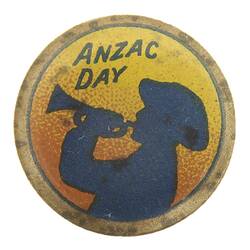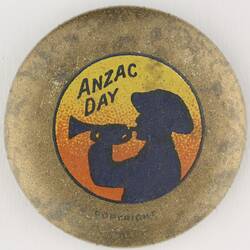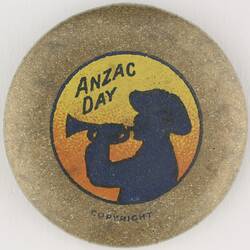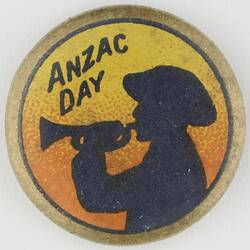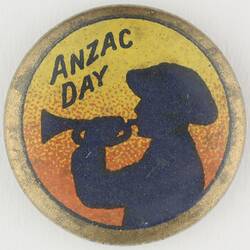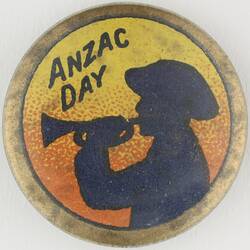Summary
Alternative Name(s): Pin, Button
Anzac Day Badge, possibly dating from World War I.
Anzac Day is an Australian national holiday to commemorate the landing at Gallipoli by the Australian and New Zealand Army Corps (ANZACs) on 25 April 1915. The day was officially designated as 'Anzac Day' on 25 April 1916.
This badge is likely to have been sold as both a way to commemorate the Gallipoli landing and raise funds for the troops overseas. It is also possible that the badge was made for fundraising after the war to support returned veterans.
One of 13 fundraising badges originally attached to a blue velvet ribbon. The badges all date from the World War I era, 1914-1919. They were purchased or collected by the donor's great-grandmother, Mrs Lillie Mary Holinger. The Hollinger family lived at Panton Hill when World War I broke out. They moved to Canterbury, Melbourne, in 1918, and in the 1930s moved to Ferny Creek. Mrs Holinger's daughter, also Lillie Mary, born in 1896, married returned serviceman David James Gillespie in 1922.
Badges were displayed on ribbons during and after World War I, commemorating involvement in the war effort. Rosalie Triolo notes that children particularly enjoyed displaying badges that they had bought as fund-raisers for the war. One former child, Winifred Grassick, remembered that Red Cross buttons were posted to schools each month by the Education Department. to be sold for a shilling each. 'They surely must have raised a significant sum because they were a regular feature of even our small school. We took an interest and pride in being able to display a ribbon containing the whole sequence', she remembered. (Rosalie Triolo, 2012, 'Our Schools and the War', p.81).
The badges have been removed from their original ribbon by Museum Victoria staff for conservation reasons.
Physical Description
Circular pressed metal badge with a plastic covered obverse, and a metal back with an attached pin. Printed text and an illustration appears in blue, yellow, orange and gold ink. On the obverse, printed text above a silhouette of a soldier playing a bugle appears on a yellow and orange background, enclosed by blue and and gold circular borders. There is printed text on the bottom edge of the badge in blue ink.
Significance
The Museum already holds a fair collection of fund-raising badges and some research has been done on their meaning and significance (see Supp. File 95.211) This acquisition allows us to add some additional examples, and also shows how a family's collection was stored after the War.
More Information
-
Collecting Areas
-
Acquisition Information
Donation from Mrs Bronwyn Mitchell, 15 Feb 1994
-
Place & Date Used
-
Inscriptions
Text: ANZAC/DAY.
-
Classification
-
Category
-
Discipline
-
Type of item
-
Overall Dimensions
2.2 cm (Width)
-
References
'About Anzac Day,' Australian Army, [Link 1]
-
Keywords
Anzac Day, Commemorations, Fundraising, Wars & Conflicts, World War I, 1914-1918

